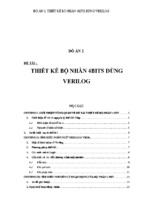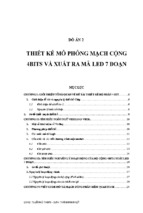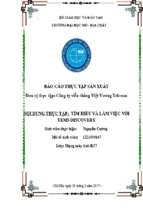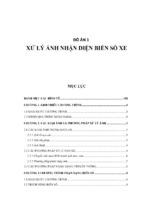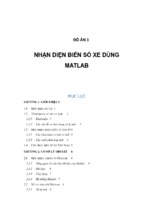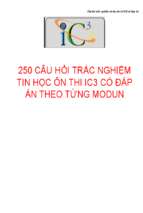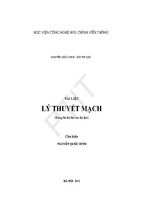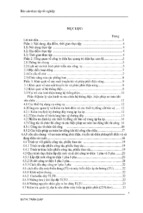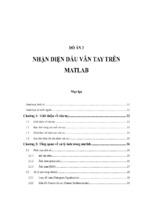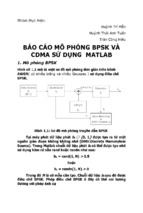- PHÂN TÍCH YÊU CẦU PHẦN MỀM
IT4460 - PHÂN TÍCH YÊU CẦU PHẦN MỀM
Năm học 2014-2015
Giảng viên: PGS. TS.Huỳnh Quyết Thắng
BM Công nghệ phần mềm
Viện CNTT-TT, ĐHBK HN
www.soict.hust.edu.vn/~thanghq
1
Chương 1. Tổng quan về YCPM và quy trình TKXDPM
I. Các khái niệm căn bản và định nghĩa
1. Các khái niệm và định nghĩa
2. Quá trình phát triển của phương pháp tiếp cận thiết
kế và xây dựng phần mềm
3. Phân loại phần mềm theo ứng dụng
4. Quy trình phát triển phần mềm (SDLC)
5. Một số lưu ý liên quan đến YCPM
II. Phân loại các yêu cầu phần mềm
III. Các thuộc tính chất lượng của yêu cầu phần mềm
IV. Quy trình yêu cầu phần mềm: mô hình, tác nhân, hỗ trợ
và quản lí, kết quả
V. Giới thiệu một số tài liệu liên quan đến nội dung chương
2
I. Các khái niệm căn bản và định nghĩa
1)
2)
3)
4)
5)
6)
7)
8)
9)
10)
11)
Công nghệ phần mềm (Software Engineering)
Yêu cầu phần mềm (Software requirements)
Thiết kế phần mềm (Software design)
Xây dựng phần mềm (Software construction)
Kiểm thử phần mềm (Software testing)
Bảo trì phần mềm (Software maintenance)
Quản lý cấu hình phần mềm (Software configuration
management)
Quản trị công nghệ phần mềm (Software engineering
management)
Quá trình công nghệ phần mềm (Software engineering process)
Các công cụ và phương pháp trong CNPM (Software
engineering tools and methods)
Chất lượng phần mềm (Software quality)
3
I. Các khái niệm căn bản và định nghĩa
1) Công nghệ phần mềm (Software Engineering)
Theo tổ chức IEEE trong “IEEE Standard Glossary of Software
Engineering Terminology,” IEEE, Piscataway, NJ std 610.121990, 1990.
Công nghệ phần mềm được định nghĩa (nguyên văn):
(1) The application of a systematic, disciplined, quantifiable
approach to the development, operation, and maintenance of
software; that is, the application of engineering to software.
Từ khóa: hệ thống, khoa học, định lượng, phát triển, sử dụng và
bảo trì phần mềm
(2) The study of approaches as in (1)
Từ khóa: nghiên cứu các hướng tiếp cận
4
I. Các khái niệm căn bản và định nghĩa
2) Yêu cầu phần mềm (Software requirements)
A requirement is defined as a property that must be exhibited in
order to solve some real-world problem.
Từ khóa: property (thuộc tính/yêu cầu)
3) Thiết kế phần mềm (Software design) [IEEE610.12-90]:
Design is both “the process of defining the architecture,
components, interfaces, and other characteristics of a system or
component” and “the result of [that] process.”
Từ khóa: process; kết quả của process; kiến trúc; thành phần; giao
diện; các thuộc tính của hệ thống
4) Xây dựng phần mềm (Software construction)
Software construction refers to the detailed creation of working,
meaningful software through a combination of coding,
verification, unit testing, integration testing, and debugging.
5
I. Các khái niệm căn bản và định nghĩa
5) Kiểm thử phần mềm (Software testing)
Software Testing consists of the dynamic verification of the
behavior of a program on a finite set of test cases, suitably
selected from the usually infinite executions domain, against
the expected behavior.
6) Bảo trì phần mềm (Software maintenance)
The maintenance phase of the lifecycle commences upon
delivery but maintenance activities occur much earlier. Once in
operation, anomalies are uncovered, operating environments
change, and new user requirements surface.
6
I. Các khái niệm căn bản và định nghĩa
7) Quản lý cấu hình phần mềm (Software configuration
management)
Software Configuration Management (SCM) is the discipline
of identifying the configuration of software at distinct points in
time for the purpose of systematically controlling changes to
the configuration and of maintaining the integrity and
traceability of the configuration throughout the system life
cycle.
Management of the SCM process. It covers the topics of the
organizational context for SCM, constraints and guidance for
SCM, planning for SCM, the SCM plan itself, and surveillance
of SCM.
7
I. Các khái niệm căn bản và định nghĩa
7) Quản lý cấu hình phần mềm (Software configuration
management)
Software configuration identification, which identifies items to
be controlled, establishes identification schemes for the items
and their versions, and establishes the tools and techniques to
be used in acquiring and managing controlled items. The first
topics in this sub-area are identification of the items to be
controlled and the software library.
Software configuration control, which is the management of
changes during the software life cycle. The topics are: first,
requesting, evaluating, and approving software changes;
second, implementing software changes; and third, deviations,
and waivers.
8
I. Các khái niệm căn bản và định nghĩa
7) Quản lý cấu hình phần mềm (Software configuration
management)
software configuration status accounting. Its topics are
software configuration status information and software
configuration status reporting.
software configuration auditing. It consists of software
functional configuration auditing, software physical
configuration auditing, and in-process audits of a software
baseline.
software release management and delivery, covering software
building and software release management.
9
I. Các khái niệm căn bản và định nghĩa
8) Quản trị công nghệ phần mềm (Software engineering
management)
The Software Engineering Management addresses the
management and measurement of software engineering. While
measurement is an important aspect, it is here that the topic of
measurement programs is presented. There are six sub-areas
for software engineering management. The first five cover
software project management and the sixth describes the
software measurement programs.
The first sub-area is initiation and scope definition, which
comprises determination and negotiation of requirements,
feasibility analysis, and process for the review and revision of
requirements.
11
I. Các khái niệm căn bản và định nghĩa
8) Quản trị công nghệ phần mềm (Software engineering
management)
The second sub-area is software project planning, and includes
process planning, determining deliverables, effort, schedule
and cost estimation, resource allocation, risk management,
quality management, and plan management.
The third sub-area is software project enactment. The topics
here are implementation of plans, supplier contract
management, implementation of measurement process, monitor
process, control process, and reporting.
The fourth sub-area is review and evaluation, which includes
the topics of determining satisfaction of requirements and
reviewing and evaluating performance.
12
I. Các khái niệm căn bản và định nghĩa
8) Quản trị công nghệ phần mềm (Software engineering
management)
The fifth sub-area describes closure: determining closure and
closure activities.
Finally, the sixth sub-area describes software engineering
measurement, more specifically, measurement programs.
The topics of this sub-area are: establish and sustain
measurement commitment, plan the measurement process,
perform the measurement process, and evaluate measurement.
13
I. Các khái niệm căn bản và định nghĩa
9) Quá trình công nghệ phần mềm (Software engineering process)
The Software Engineering Process is concerned with the
definition,
implementation,
assessment,
measurement,
management, change, and improvement of the software
engineering process itself. It is divided into four subareas.
The first sub-area presents process implementation and
change. The topics here are process infrastructure, the software
process management cycle, models for process implementation
and change, and practical considerations.
The second sub-area deals with process definition. It includes
the topics of software life cycle models, software life-cycle
processes, notations for process definitions, process adaptation,
and automation
14
I. Các khái niệm căn bản và định nghĩa
9) Quá trình công nghệ phần mềm (Software engineering process)
The third sub-area is process assessment. The topics here
include process assessment models and process assessment
methods.
The fourth sub-area describes process and product
measurements. The software engineering process covers
general product measurement, as well as process measurement
in general. The topics are process measurement, software
product measurement, quality of measurement results, software
information models, and process measurement techniques.
15
I. Các khái niệm căn bản và định nghĩa
10) Các công cụ và phương pháp trong CNPM Software
engineering tools and methods
The Software Engineering Tools and Methods includes both
software engineering tools and software engineering methods.
The software engineering tools sub-area uses the same
structure, with one topic for each of the other nine software
engineering topics. An additional topic is provided:
miscellaneous tools issues, such as tool integration techniques,
which are potentially applicable to all classes of tools.
The software engineering methods sub-area is divided into four
subsections: heuristic methods dealing with informal
approaches, formal methods dealing with mathematically based
approaches, and prototyping methods dealing with software
development approachesbased on various forms of prototyping.
16
I. Các khái niệm căn bản và định nghĩa
11) Chất lượng phần mềm (Software quality)
The Software Quality deals with software quality
considerations which transcend the software life cycle
processes. Since software quality is a ubiquitous concern in
software engineering, it is also considered in many of the other
topics. The description of this topic covers three sub-areas.
The first sub-area describes the software quality fundamentals
such as software engineering culture and ethics, the value and
costs of quality, models and quality characteristics, and quality
improvement.
17
I. Các khái niệm căn bản và định nghĩa
11) Chất lượng phần mềm (Software quality)
The second sub-area covers software quality management
processes. The topics here are software quality assurance,
verification and validation, and reviews and audits.
The third and final sub-area describes practical considerations
related to software quality. The topics are software quality
requirements, defect characterization, software quality
management techniques, and software quality measurement.
18
Chương 1. Tổng quan về YCPM và quy trình TKXDPM
I. Các khái niệm căn bản và định nghĩa
1. Các định nghĩa
2. Quá trình phát triển của phương pháp tiếp cận thiết
kế và xây dựng phần mềm
3. Phân loại phần mềm theo ứng dụng
4. Quy trình phát triển phần mềm (SDLC)
5. Một số lưu ý liên quan đến YCPM
II. Phân loại các yêu cầu phần mềm
III. Các thuộc tính chất lượng của yêu cầu phần mềm
IV. Quy trình yêu cầu phần mềm: mô hình, tác nhân, hỗ trợ
và quản lí, kết quả
V. Giới thiệu một số tài liệu liên quan đến nội dung chương
19
I. 2. Phương pháp tiếp cận PTTK phần mềm
Hướng tiếp cận: Process-Oriented
•
•
•
•
Tập trung vào các giải thuật và thao tác xử lý dữ liệu
Quá trình phát triển phần mềm tập trung vào thể hiện các
phương pháp xử lý dữ liệu
Cấu trúc dữ liệu thông thường không thể hiện rõ
Nhược điểm của hướng tiếp cận: Các tệp dữ liệu rất khó xây
dựng để thoả mãn phần mềm
20
- Xem thêm -

